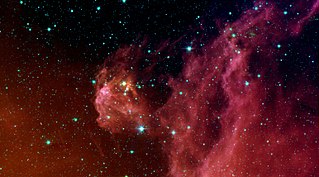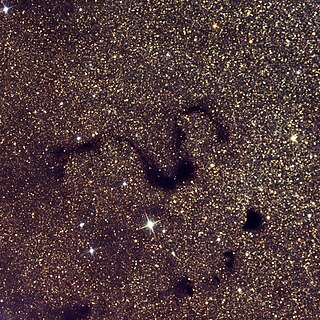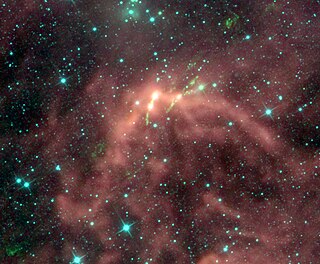 W
WThe astronomer Edward Emerson Barnard compiled a list of dark nebulae known as the Barnard Catalogue of Dark Markings in the Sky, or the Barnard Catalogue for short. The nebulae listed by Barnard have become known as Barnard objects. A 1919 version of the catalogue listed 182 nebulae; by the time of the posthumously published 1927 version, it listed 369.
 W
WBarnard 30 is a dark cloud in the Lambda Orionis ring, north of Lambda Orionis, also called Meissa. The region is about 1300 light years from Earth.
 W
WThe Horsehead Nebula is a small dark nebula in the constellation Orion. The nebula is located just to the south of Alnitak, the easternmost star of Orion's Belt, and is part of the much larger Orion Molecular Cloud Complex. It appears within the southern region of the dense dust cloud known as Lynds 1630, along the edge of the much larger, active star-forming H II region called IC 434.
 W
WThe Pipe Nebula is a dark nebula in the Ophiuchus constellation and a part of the Dark Horse Nebula. It is a large but readily apparent smoking pipe-shaped dust lane that obscures the Milky Way star clouds behind it. Clearly visible to the naked eye in the Southern United States under clear dark skies, but it is best viewed with 7x binoculars.
 W
WThe Pipe Nebula is a dark nebula in the Ophiuchus constellation and a part of the Dark Horse Nebula. It is a large but readily apparent smoking pipe-shaped dust lane that obscures the Milky Way star clouds behind it. Clearly visible to the naked eye in the Southern United States under clear dark skies, but it is best viewed with 7x binoculars.
 W
WThe Pipe Nebula is a dark nebula in the Ophiuchus constellation and a part of the Dark Horse Nebula. It is a large but readily apparent smoking pipe-shaped dust lane that obscures the Milky Way star clouds behind it. Clearly visible to the naked eye in the Southern United States under clear dark skies, but it is best viewed with 7x binoculars.
 W
WThe Pipe Nebula is a dark nebula in the Ophiuchus constellation and a part of the Dark Horse Nebula. It is a large but readily apparent smoking pipe-shaped dust lane that obscures the Milky Way star clouds behind it. Clearly visible to the naked eye in the Southern United States under clear dark skies, but it is best viewed with 7x binoculars.
 W
WBarnard 68 is a molecular cloud, dark absorption nebula or Bok globule, towards the southern constellation Ophiuchus and well within our own galaxy at a distance of about 400 light-years, so close that not a single star can be seen between it and the Sun. American astronomer Edward Emerson Barnard added this nebula to his catalog of dark nebulae in 1919. His catalog was published in 1927, at which stage it included some 350 objects. Because of its opacity, its interior is extremely cold, its temperature being about 16 K (−257 °C). Its mass is about twice that of the Sun and it measures about half a light-year across.
 W
WThe Snake Nebula is a dark nebula in the Ophiuchus constellation. It is a small but readily apparent SP-shaped dust lane that snakes out in front of the Milky Way star clouds from the north-north-west edge of the bowl of the Pipe Nebula. Its thickness runs between 2′ and 3′ and runs around 6′ in the north-west / south-east orientation. A good view in a 4" to 6" telescope requires clear dark skies.
 W
WThe Pipe Nebula is a dark nebula in the Ophiuchus constellation and a part of the Dark Horse Nebula. It is a large but readily apparent smoking pipe-shaped dust lane that obscures the Milky Way star clouds behind it. Clearly visible to the naked eye in the Southern United States under clear dark skies, but it is best viewed with 7x binoculars.
 W
WThe "E" or "Barnard's E" Nebula is a pair of dark nebula in the Aquila constellation. It is a well-defined dark area on a background of Milky Way consisting of countless stars of all magnitudes. Its size is about that of the full moon, or roughly 0.5 degrees, and its distance from earth is estimated at about 2,000 light years.
 W
WThe "E" or "Barnard's E" Nebula is a pair of dark nebula in the Aquila constellation. It is a well-defined dark area on a background of Milky Way consisting of countless stars of all magnitudes. Its size is about that of the full moon, or roughly 0.5 degrees, and its distance from earth is estimated at about 2,000 light years.
 W
WBarnard 147 is a narrow, snake-like dark nebula in the Cygnus constellation. It is a well-defined dark lane near open cluster NGC 6871.
 W
WBarnard 147 is a narrow, snake-like dark nebula in the Cygnus constellation. It is a well-defined dark lane near open cluster NGC 6871.
 W
WThe dark nebula Barnard 203 or Lynds 1448 is located about one degree southwest of NGC 1333 in the Perseus molecular cloud, at a distance of about 800 light-years. Three infrared sources were observed in this region by IRAS, called IRS 1, IRS 2 and IRS 3.
 W
WThe "E" or "Barnard's E" Nebula is a pair of dark nebula in the Aquila constellation. It is a well-defined dark area on a background of Milky Way consisting of countless stars of all magnitudes. Its size is about that of the full moon, or roughly 0.5 degrees, and its distance from earth is estimated at about 2,000 light years.
 W
WThe Horsehead Nebula is a small dark nebula in the constellation Orion. The nebula is located just to the south of Alnitak, the easternmost star of Orion's Belt, and is part of the much larger Orion Molecular Cloud Complex. It appears within the southern region of the dense dust cloud known as Lynds 1630, along the edge of the much larger, active star-forming H II region called IC 434.
 W
WThe Pipe Nebula is a dark nebula in the Ophiuchus constellation and a part of the Dark Horse Nebula. It is a large but readily apparent smoking pipe-shaped dust lane that obscures the Milky Way star clouds behind it. Clearly visible to the naked eye in the Southern United States under clear dark skies, but it is best viewed with 7x binoculars.
 W
WThe Snake Nebula is a dark nebula in the Ophiuchus constellation. It is a small but readily apparent SP-shaped dust lane that snakes out in front of the Milky Way star clouds from the north-north-west edge of the bowl of the Pipe Nebula. Its thickness runs between 2′ and 3′ and runs around 6′ in the north-west / south-east orientation. A good view in a 4" to 6" telescope requires clear dark skies.